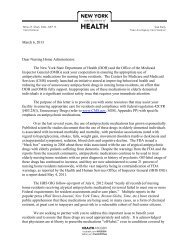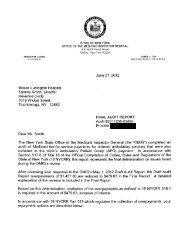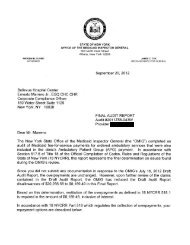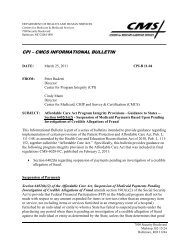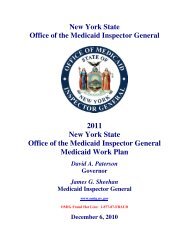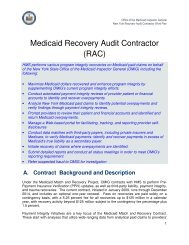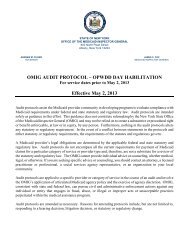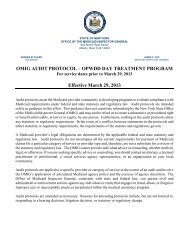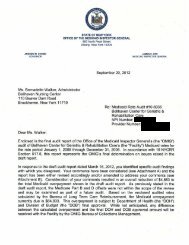PDF Version - New York State Office of the Medicaid Inspector General
PDF Version - New York State Office of the Medicaid Inspector General
PDF Version - New York State Office of the Medicaid Inspector General
Create successful ePaper yourself
Turn your PDF publications into a flip-book with our unique Google optimized e-Paper software.
EARLY INTERVENTION<br />
PROGRAM FOR INFANTS<br />
AND TODDLERS WITH<br />
DISABILITIES-MEDICAID<br />
COMPLIANCE<br />
3/30/11<br />
JAMES G. SHEEHAN<br />
NEW YORK MEDICAID INSPECTOR GENERAL<br />
James.Sheehan@OMIG.NY.GOV<br />
518-473-3782
2011<br />
• GOVERNOR CUOMO’S STATE OF THE STATE<br />
(January 5, 2011):<br />
– MEDICAID AS ONE OF THREE PRIMARY FOCUS<br />
AREAS<br />
– NOT BUDGET CUTTING OR TRIMMING, BUT -<br />
REINVENTING, REORGANIZING, AND REDESIGNING<br />
PROGRAMS AND AGENCIES<br />
– MEDICAID REDESIGN TEAM<br />
– REQUIRES THOROUGH REVIEW OF MEDICAID<br />
PROGRAMS AND AGENCY PRACTICES<br />
– ON-TIME BUDGET 2011<br />
2
PURPOSE OF OMIG WEBINARS-<br />
FULFILLING OMIG’S DUTY IN NYS<br />
PHL SECTION 32 -<br />
• § 32(17) “ . . . to conduct educational programs<br />
for medical assistance program providers,<br />
vendors, contractors and recipients designed to<br />
limit fraud and abuse within <strong>the</strong> medical<br />
assistance program.”<br />
• These programs will be scheduled as needed by<br />
<strong>the</strong> provider community. Your feedback on this<br />
program, and suggestions for new topics are<br />
appreciated.<br />
• Next program: Preschool/School Supportive<br />
Health Services Program (SSHSP) <strong>Medicaid</strong>-in-<br />
Education<br />
3
GOALS OF THIS PROGRAM<br />
• Education for <strong>Medicaid</strong> providers and<br />
municipal/county governmental entities on<br />
compliance with <strong>Medicaid</strong> payment requirements<br />
• Federal funding brings federal oversight-provider<br />
and municipality responsibilities under <strong>Medicaid</strong><br />
• Responsibilities <strong>of</strong> OMIG and DOH<br />
• Audit process and approach<br />
4
CONCERNS OF THIS PROGRAM<br />
• Complexity <strong>of</strong> Early Intervention rules-,<br />
<strong>Medicaid</strong>, Private Insurance, Education<br />
• Complexity <strong>of</strong> Early Intervention reimbursement-<br />
<strong>Medicaid</strong>, state/county, (through localities and<br />
state general fund) private<br />
• Not a choice-counties obligated to assure<br />
provision <strong>of</strong> early intervention services, obligated<br />
to address billing and payment issues<br />
5
EARLY INTERVENTION-MEDICAID<br />
• Total <strong>Medicaid</strong> EI expenditures in NY $262<br />
million (2010)<br />
• Federal share $131 million<br />
• NY City=$205 million total expenditures<br />
6
Early Intervention – for “infants<br />
and toddlers with disabilities”<br />
• (1) Are experiencing developmental delays, as measured<br />
by appropriate diagnostic instruments and procedures, in<br />
one or more <strong>of</strong> <strong>the</strong> following areas:<br />
– (i) Cognitive development.<br />
– (ii) Physical development, including vision and hearing.<br />
– (iii) Communication development.<br />
– (iv) Social or emotional development.<br />
– (v) Adaptive development;<br />
• (2) Have a diagnosed physical or mental condition that<br />
has a high probability <strong>of</strong> resulting in developmental delay<br />
7
THE EARLY INTERVENTION<br />
PROGRAM FEDERAL LAW AND<br />
REGULATIONS<br />
• Individuals with Disabilities Education Act,<br />
Part C, Sec. 631, as amended; 20 U.S.C.<br />
1431 et seq.<br />
• 34 CFR 303<br />
Available:<br />
http://www2.ed.gov/programs/osepeip/le<br />
gislation.html<br />
8
EARLY INTERVENTION STATE LAW<br />
AND REGULATIONS<br />
• Title II-A <strong>of</strong> Article 25 <strong>of</strong> <strong>the</strong> Public Health Law<br />
• Subpart 69-4: Regulations for <strong>the</strong> Early<br />
Intervention Program (10 NYCRR Part 69-4)<br />
• http://www.health.state.ny.us/community/infant<br />
s_children/early_intervention/regulations.htm<br />
9
CORE MEDICAID REQUIREMENTS<br />
18 NYCRR 504.3 FOR ALL<br />
PROVIDERS<br />
• <strong>Medicaid</strong> is payment in full-no balance billing<br />
• Bill for only services which are medically necessary and<br />
actually furnished<br />
• Bill only for services to eligible persons<br />
• Permit audits. . . <strong>of</strong> all books and records relating to<br />
services furnished and payments received, including<br />
patient histories, case files, and patient-specific data<br />
• Provide information in relation to any claim . . . Which is<br />
true, accurate, and complete.<br />
• “to comply with <strong>the</strong> rules, regulations, and <strong>of</strong>ficial<br />
directives <strong>of</strong> <strong>the</strong> department.”<br />
10
WHO MAY AUDIT MEDICAID<br />
EARLY INTERVENTION PAYMENTS?<br />
• <strong>Office</strong> <strong>of</strong> <strong>Medicaid</strong> <strong>Inspector</strong> <strong>General</strong> (NY)<br />
• HHS and Education <strong>Office</strong> <strong>of</strong> <strong>Inspector</strong> <strong>General</strong> (federal)<br />
• <strong>Medicaid</strong> Fraud Control Unit (NY)<br />
• <strong>Medicaid</strong> Integrity Contractor (CMS)<br />
• NYS Department <strong>of</strong> Health fiscal audits, which may<br />
include a site visit, <strong>of</strong> all or any <strong>of</strong> <strong>the</strong> following:<br />
municipalities, service coordinators, evaluators, or<br />
providers <strong>of</strong> early intervention services. (also performed<br />
by contractors)<br />
• <strong>Office</strong> <strong>of</strong> <strong>State</strong> Comptroller (NY)<br />
• Counties and County Comptrollers<br />
• GAO<br />
11
OTHER AUDIT/INVESTIGATIVE<br />
RISKS<br />
• <strong>New</strong> <strong>York</strong> Attorney <strong>General</strong> actions under<br />
<strong>the</strong> <strong>New</strong> <strong>York</strong> False Claims Act<br />
• Whistleblower actions under <strong>the</strong> <strong>New</strong> <strong>York</strong><br />
False Claims Act (<strong>the</strong>se cases limited to<br />
private entities)<br />
• Claims under <strong>the</strong> federal False Claims Act<br />
12
WHO MAY BE AUDITED?<br />
• Municipality (county) submitting claim<br />
• Contracted provider <strong>of</strong> services<br />
• Service bureau, billing service, or<br />
electronic media billers preparing or<br />
submitting claims (See 18 NYCRR 504.9)<br />
13
Federal HHS OIG AUDIT 2010 -<br />
Review <strong>of</strong> Early Intervention<br />
Services Costs Claimed by <strong>New</strong><br />
Jersey to <strong>the</strong> <strong>Medicaid</strong> Program<br />
• <strong>the</strong> child receiving <strong>the</strong> related service was enrolled in <strong>the</strong> <strong>Medicaid</strong><br />
program;<br />
• <strong>the</strong> related service was covered under <strong>the</strong> program;<br />
• <strong>the</strong> related service was listed in <strong>the</strong> child’s treatment plan<br />
(Individualized Family Service Plan); and<br />
• <strong>the</strong> <strong>State</strong> agency paid <strong>the</strong> claims within 1 year <strong>of</strong> <strong>the</strong> date <strong>of</strong><br />
receipt.<br />
• http://oig.hhs.gov/oas/reports/region2/20801019.pdf<br />
14
RESULT OF 2010 HHS/OIG AUDIT<br />
OF NEW JERSEY<br />
• Claims for early intervention submitted as a result <strong>of</strong><br />
<strong>New</strong> Jersey’s “contract with Covansys did not always<br />
comply with Federal and <strong>State</strong> regulations. Of <strong>the</strong> 100<br />
claims in our random sample, 94 complied with Federal<br />
and <strong>State</strong> requirements, but 6 did not. Of <strong>the</strong> six<br />
noncompliant claims, two claims contained services that<br />
were not provided or supported, and four claims were<br />
not timely submitted. These deficiencies occurred<br />
because <strong>the</strong> <strong>State</strong> did not effectively monitor <strong>the</strong> early<br />
intervention program for compliance with certain federal<br />
and state requirements.”<br />
• http://oig.hhs.gov/oas/reports/region2/20801019.pdf<br />
15
WHAT YOU HAVE PROMISED TO<br />
DO<br />
• Application for Approval <strong>of</strong> Individual<br />
Evaluators, Service Providers and Service<br />
Coordinators<br />
• DOH-3735(3/05)<br />
• Codified in 10 NYCRR 69-4.5<br />
• Re-application process not yet<br />
implemented<br />
16
WHAT YOU HAVE PROMISED (AND<br />
WE CHECK)<br />
• Attest to character and competence; (how determine?)<br />
• Assure <strong>the</strong> maintenance <strong>of</strong> current state licensure and/or certification and<br />
demonstrated pr<strong>of</strong>iciency in early childhood development<br />
• Assure that he/she will notify <strong>the</strong> Department within two working days <strong>of</strong><br />
suspension, expiration, or revocation <strong>of</strong> licensure, certification or<br />
registration;<br />
• Participate in in-service training or o<strong>the</strong>r forms <strong>of</strong> pr<strong>of</strong>essional training and<br />
education related to <strong>the</strong> delivery <strong>of</strong> early intervention services;<br />
• Agree to enter into an approved <strong>Medicaid</strong> Provider Agreement and to<br />
reassign <strong>Medicaid</strong> benefits to <strong>the</strong> local county early intervention program or<br />
City <strong>of</strong> <strong>New</strong> <strong>York</strong> early intervention program;<br />
• Assure compliance with <strong>the</strong> confidentiality requirements set forth in<br />
regulation.<br />
• DOH-3735(3/05) 10 NYCRR 69-4.5<br />
17
WHAT YOU HAVE PROMISED<br />
– Keep any records necessary to disclose <strong>the</strong> extent <strong>of</strong> services<br />
<strong>the</strong> Provider furnishes to recipients receiving assistance under<br />
<strong>the</strong> <strong>New</strong> <strong>York</strong> <strong>State</strong> Plan for Medical Assistance;<br />
– On request, furnish <strong>the</strong> <strong>New</strong> <strong>York</strong> <strong>State</strong> Department <strong>of</strong> Health,<br />
or its designee, and <strong>the</strong> Secretary <strong>of</strong> <strong>the</strong> United <strong>State</strong>s<br />
Department <strong>of</strong> Health and Human Services, and <strong>the</strong> <strong>New</strong> <strong>York</strong><br />
<strong>State</strong> <strong>Medicaid</strong> Fraud Control Unit any information maintained<br />
under paragraph (A) (1), and any information regarding any<br />
<strong>Medicaid</strong> claims reassigned by <strong>the</strong> Provider to <strong>the</strong> local early<br />
intervention agency;<br />
– Abide by all applicable Federal and <strong>State</strong> laws and regulations,<br />
including <strong>the</strong> Social Security Act, <strong>New</strong> <strong>York</strong> <strong>State</strong> Social<br />
Services Law, part 42 <strong>of</strong> <strong>the</strong> Code <strong>of</strong> Federal Regulations and<br />
Title 18 <strong>of</strong> <strong>the</strong> Codes, Rules and Regulations <strong>of</strong> <strong>the</strong> <strong>State</strong> <strong>of</strong><br />
<strong>New</strong> <strong>York</strong><br />
– DOH-3735(3/05) 10 NYCRR 69-4.5<br />
18
Limiting fraud and abuse<br />
within <strong>the</strong> <strong>Medicaid</strong> program<br />
• “Fraud means an intentional deception<br />
or misrepresentation made with <strong>the</strong><br />
knowledge that <strong>the</strong> deception could result<br />
in an unauthorized benefit to <strong>the</strong> provider<br />
or ano<strong>the</strong>r person . . .” 18 NYCRR 515.1<br />
19
Limiting fraud and abuse<br />
within <strong>the</strong> <strong>Medicaid</strong> program<br />
• “Abuse means provider practices that are inconsistent with sound fiscal,<br />
business, or medical practices, and result in an unnecessary cost to <strong>the</strong><br />
<strong>Medicaid</strong> program, or in reimbursement for services that are not medically<br />
necessary or that fail to meet pr<strong>of</strong>essionally recognized standards for<br />
health care. It also includes recipient practices that result in unnecessary<br />
cost to <strong>the</strong> <strong>Medicaid</strong> program.” 42 CFR 455.2-similar provision in state<br />
regulations 18 NYCRR 515.1 (b)<br />
• “Abuse” does not require intentional conduct-it is measured by objective<br />
measures<br />
–Medically unnecessary care<br />
–Care that fails to meet recognized pr<strong>of</strong>essional standards<br />
–“provider practices that are inconsistent with sound fiscal . . .practices”<br />
–failing to bill o<strong>the</strong>r payors<br />
20
THE SIX GREATEST MEDICAID<br />
PROGRAM RISKS IN EI<br />
• RISK #1: Using excluded persons to provide services reimbursable by<br />
<strong>Medicaid</strong>.<br />
• RISK #2: Failing to refund identified overpayments to <strong>the</strong> <strong>Medicaid</strong><br />
program.<br />
• RISK #3: Failing to maintain an “effective” compliance program as required<br />
by 18 NYCRR 521 (if over $500,000).<br />
• RISK #4: Failing to require and maintain records demonstrating medical<br />
necessity (as shown by authorization) , authorization, and actual<br />
performance <strong>of</strong> a reimbursable service.<br />
• RISK #5: Failing to supervise service bureaus or billing companies<br />
submitting claims or receiving payment.<br />
• RISK #6: Failing to assure proper payment by third parties before <strong>Medicaid</strong>.<br />
21
RISK #1: Using Excluded Persons<br />
to Provide Services Reimbursable<br />
by <strong>Medicaid</strong><br />
• See OMIG’s Exclusion Webinar on our<br />
website at<br />
http://www.omig.ny.gov/data/images/stor<br />
ies/Webinar/6-8-<br />
10_exclusion_webinar_final.ppt<br />
22
Program Exclusions<br />
• Statute<br />
• Regulation<br />
• Federal OIG Guidance<br />
• Federal CMS Guidance<br />
• <strong>State</strong> Guidance Mandated by CMS<br />
• Condition <strong>of</strong> NY provider enrollment or NY state<br />
contract<br />
• Virtually no case law (criminal, civil, or<br />
administrative) on extent and effect <strong>of</strong> exclusion<br />
23
CMS EXCLUSION REGULATION<br />
• “No payment will be made by Medicare,<br />
<strong>Medicaid</strong> or any <strong>of</strong> <strong>the</strong> o<strong>the</strong>r federal health care<br />
programs for any item or service furnished by<br />
an excluded individual or entity, or at <strong>the</strong><br />
medical direction or on <strong>the</strong> prescription <strong>of</strong> a<br />
physician or o<strong>the</strong>r authorized individual who is<br />
excluded when <strong>the</strong> person furnishing such item<br />
or service knew or had reason to know <strong>of</strong> <strong>the</strong><br />
exclusion.” 42 CFR 1001.1901 (b)<br />
• Focus is not on <strong>the</strong> relationship but on <strong>the</strong><br />
payment.<br />
24
PROGRAM EXCLUSION<br />
• Federal authority and requirement on<br />
providers<br />
– No claims based on work <strong>of</strong> excluded persons<br />
• Federal authority and mandate on state<br />
<strong>Medicaid</strong> programs<br />
– No state <strong>Medicaid</strong> claims to CMS based on<br />
work <strong>of</strong> excluded persons<br />
25
Impact <strong>of</strong> Exclusion on Health Care<br />
Providers<br />
•Once exclusion occurs, health care providers:<br />
– May employ or contract with excluded persons, but<br />
may not allow excluded persons to provide or to<br />
direct <strong>the</strong> ordering or delivery <strong>of</strong> services or<br />
supplies, or to undertake certain administrative<br />
duties (IFSP team evaluator, service providers,<br />
service coordinators, local early intervention<br />
<strong>of</strong>ficial)<br />
– Whe<strong>the</strong>r or not direct care activities are involved<br />
– If any part <strong>of</strong> <strong>the</strong> task is reimbursed by federal<br />
program (<strong>Medicaid</strong>) dollars<br />
– Note: Staffing agencies must screen potential<br />
candidates to ensure that <strong>the</strong>y have not been<br />
excluded prior to being sent to providers for work.<br />
Providers must develop and enforce contractual<br />
agreements to ensure prescreening occurs.<br />
26
THE NEW YORK STATE<br />
EXCLUSION REGULATION<br />
•18 NYCRR 515.5 Sanctions effect: (a)<br />
No payments will be made to or on behalf<br />
<strong>of</strong> any person for <strong>the</strong> medical care,<br />
services or supplies furnished by or under<br />
<strong>the</strong> supervision <strong>of</strong> <strong>the</strong> person during a<br />
period <strong>of</strong> exclusion or in violation <strong>of</strong> any<br />
condition <strong>of</strong> participation in <strong>the</strong> program.<br />
27
RISK #2: Failing to Refund<br />
Identified Overpayments to <strong>the</strong><br />
<strong>Medicaid</strong> Program- ACA § 6402<br />
• ‘‘(d) REPORTING AND RETURNING OF<br />
OVERPAYMENTS—<br />
• ‘‘(1) IN GENERAL — If a person has received an<br />
overpayment, <strong>the</strong> person shall—<br />
• ‘‘(A) report and return <strong>the</strong> overpayment to <strong>the</strong><br />
Secretary, <strong>the</strong> <strong>State</strong>, an intermediary, a carrier, or a<br />
contractor, as appropriate, at <strong>the</strong> correct address;<br />
and<br />
• ‘‘(B) notify <strong>the</strong> Secretary, <strong>State</strong>, intermediary, carrier,<br />
or contractor to whom <strong>the</strong> overpayment was<br />
returned in writing <strong>of</strong> <strong>the</strong> reason for <strong>the</strong><br />
overpayment . . .<br />
28
ACA § 6402 and False Claims Act<br />
• Failure to report, refund, and explain<br />
overpayments within 60 days <strong>of</strong><br />
identification can give rise to a claim <strong>of</strong><br />
“knowing” failure to repay under <strong>the</strong> False<br />
Claims Act<br />
• See OMIG Webinar:<br />
http://www.omig.ny.gov/data/images/stor<br />
ies/Webinar/7-14-10_ppaca_webinar.ppt<br />
29
RETURNING OVERPAYMENTS IN<br />
NEW YORK TO THE MEDICAID<br />
PROGRAM<br />
• Report and return <strong>the</strong> overpayment to <strong>the</strong> <strong>State</strong> at <strong>the</strong><br />
correct address<br />
• In <strong>New</strong> <strong>York</strong>, <strong>Medicaid</strong> overpayments should be returned,<br />
reported, and explained to OMIG<br />
• OMIG’s correct address:<br />
– <strong>Office</strong> <strong>of</strong> <strong>the</strong> <strong>Medicaid</strong> <strong>Inspector</strong> <strong>General</strong><br />
– 800 North Pearl Street<br />
– Albany, <strong>New</strong> <strong>York</strong> 12204<br />
• May also use DOH adjustment process for multiple funders<br />
through Brad Hutton (BJH08@Health.<strong>State</strong>.NY.US)<br />
30
VOIDS AND SMALL<br />
OVERPAYMENTS<br />
• Providers may use void process through CSC (<strong>the</strong> eMedNY claims system)<br />
for smaller or routine claims. A void is submitted to negate a previously<br />
paid claim based upon a billing error or late reimbursement by a primary<br />
carrier.<br />
• Overpayments <strong>of</strong> smaller or routine claims which cannot be attributed to<br />
billing error or late reimbursement by a primary carrier should be reported<br />
to CSC in writing. These should include known mistakes in CSC or DOH<br />
billing and payment programs.<br />
• eMedNY call center: 1-800-343-9000, M – F, 7:30 am – 6:00 pm; email:<br />
HIPAADESK3@csc.com<br />
• See http://www emedny.org/provider manuals for instructions on<br />
submission <strong>of</strong> voids.<br />
• NYEIS System also can be used to initiate report and refund process<br />
31
WHAT IS AN “OVERPAYMENT”?<br />
• ‘‘(B) OVERPAYMENT—The term<br />
‘‘overpayment’’ means any funds that a<br />
person receives or retains under title<br />
XVIII (Medicare) or XIX (<strong>Medicaid</strong>) to<br />
which <strong>the</strong> person, after applicable<br />
reconciliation, is not entitled under such<br />
title”<br />
• “funds” not “benefit”<br />
32
WHO MUST RETURN THE<br />
OVERPAYMENT?<br />
• A “person” (which includes corporations and<br />
partnerships) who has “received” or “retained” <strong>the</strong><br />
overpayment<br />
• Focus on “receipt”; payment need not come directly<br />
from <strong>Medicaid</strong>; if “person” “retains” overpayment due<br />
<strong>the</strong> program, violation occurs<br />
• “person” includes a an individual program enrollee or<br />
subcontractor as well as a program provider or supplier<br />
• Is a state agency a “person”? Vermont v. US 529 U.S.<br />
765 (2000); is local government a state agency? Cook<br />
County v. US 123 S. Ct. 1239 (2003)<br />
33
WHEN MUST AN OVERPAYMENT<br />
BE RETURNED?<br />
• ACA § 6402(d)(2)<br />
• An overpayment must be reported and<br />
returned . . .by <strong>the</strong> later <strong>of</strong> -<br />
– (A) <strong>the</strong> date which is 60 days after <strong>the</strong> date<br />
on which <strong>the</strong> overpayment was identified; or<br />
– (B) <strong>the</strong> date on which any corresponding cost<br />
report is due, if applicable<br />
34
WHEN IS AN OVERPAYMENT<br />
“IDENTIFIED”?<br />
• “identified” for an organization means that <strong>the</strong> fact <strong>of</strong> an<br />
overpayment, not <strong>the</strong> amount <strong>of</strong> <strong>the</strong> overpayment has been<br />
identified. (e.g., patient was dead at time service was allegedly<br />
rendered, APG claim includes service not rendered, charge master<br />
had code crosswalk error)<br />
• Compare with language from CMS proposed 42 CFR 401.310<br />
overpayment regulation 67 FR 3665 (1/25/02 draft later withdrawn)<br />
– “If a provider, supplier, or individual identifies a Medicare payment<br />
received in excess <strong>of</strong> amounts payable under <strong>the</strong> Medicare statute and<br />
regulations, <strong>the</strong> provider, supplier, or individual must, within 60 days <strong>of</strong><br />
identifying or learning <strong>of</strong> <strong>the</strong> excess payment, return <strong>the</strong> overpayment<br />
to <strong>the</strong> appropriate intermediary or carrier.”<br />
35
WHEN IS AN OVERPAYMENT<br />
“IDENTIFIED”?<br />
• Employee or contractor identifies overpayment<br />
in hotline call or email<br />
• Patient advises that service not received<br />
• RAC advises that dual eligible Medicare<br />
overpayment has been found<br />
• OMIG sends letter re deceased patient,<br />
unlicensed or excluded employee or ordering<br />
physician<br />
• Qui tam or government lawsuit allegations<br />
• Criminal indictment or information<br />
36
DOCUMENTING GOOD FAITH<br />
EFFORT TO IDENTIFY<br />
OVERPAYMENTS<br />
• Create a record to demonstrate to <strong>the</strong> government that<br />
your organization collected or attempted to address<br />
allegations <strong>of</strong> overpayments<br />
– Develop standard form to document employee’s internal<br />
disclosure<br />
– Document interviews<br />
– Document evidence and means to determine if credible<br />
– Record employees involved in deliberations and decisions<br />
37
SOME REASONS FOR<br />
OVERPAYMENTS<br />
• Duplicate payments <strong>of</strong> <strong>the</strong> same service(s).<br />
• Incorrect provider payee.<br />
• Payment for services not authorized on IFSP.<br />
• Services not actually rendered.<br />
• Payment made by a primary insurance.<br />
• Payment for services rendered during a period<br />
<strong>of</strong> non-entitlement (transition out <strong>of</strong> program).<br />
38
MORE REASONS FOR<br />
OVERPAYMENTS<br />
• Failure to refund credit balances<br />
• Excluded ordering or servicing person<br />
• Patient deceased<br />
• Servicing person lacked required license or<br />
certification (e.g., CFY speech students<br />
beyond period <strong>of</strong> approved supervision)<br />
• Billing system error<br />
39
GOVERNMENT IS USING DATA TO<br />
DETECT OVERPAYMENTS<br />
• EXCLUDED PERSONS<br />
• DECEASED OR TRANSITIONED<br />
ENROLLEES<br />
• DECEASED PROVIDERS<br />
• CREDIT BALANCES<br />
• WHAT IS GO-BACK OBLIGATION WHEN<br />
PROVIDER IS PUT ON NOTICE THAT<br />
SYSTEMS ARE DEFICIENT?<br />
40
“OVERPAYMENT” INCLUDES:<br />
• PAYMENT RECEIVED OR RETAINED FOR<br />
SERVICES ORDERED OR PROVIDED BY<br />
EXCLUDED PERSON “no payment will be made<br />
by Medicare, <strong>Medicaid</strong> or any <strong>of</strong> <strong>the</strong> o<strong>the</strong>r<br />
Federal health care programs for any item or<br />
service furnished by an excluded individual or<br />
entity or at <strong>the</strong> medical direction or on <strong>the</strong><br />
prescription <strong>of</strong> a physician or o<strong>the</strong>r authorized<br />
individual who is excluded . . .” 42 CFR<br />
1001.1901<br />
41
OMIG DISCLOSURE GUIDANCE<br />
• “OMIG is not interested in fundamentally<br />
altering <strong>the</strong> day-to-day business processes<br />
<strong>of</strong> organizations for minor or insignificant<br />
matters. Consequently, <strong>the</strong> repayment <strong>of</strong><br />
simple, more routine occurrences <strong>of</strong><br />
overpayment should continue through<br />
typical methods <strong>of</strong> resolution, which may<br />
include voiding or adjusting <strong>the</strong> amounts<br />
<strong>of</strong> claims.”<br />
42
OMIG SELF DISCLOSURE FORM<br />
FROM WWW.OMIG.NY.GOV<br />
• You must provide written, detailed information<br />
about your self disclosure. This must include a<br />
description <strong>of</strong> <strong>the</strong> facts and circumstances<br />
surrounding <strong>the</strong> possible fraud, waste, abuse, or<br />
inappropriate payment(s), <strong>the</strong> period involved,<br />
<strong>the</strong> person(s) involved, <strong>the</strong> legal and program<br />
authorities implicated, and <strong>the</strong> estimated fiscal<br />
impact. (Please refer to <strong>the</strong> OMIG self-disclosure<br />
guidance for additional information.)<br />
43
RISK #3: Failing to Maintain an<br />
“Effective” Compliance Program as<br />
Required by 18 NYCRR 521 (if<br />
billing over $500,000 per year)<br />
• See OMIG Webinar: Evaluating<br />
Effectiveness <strong>of</strong> Compliance Programs<br />
• http://www.omig.ny.gov/data/images/stor<br />
ies/Webinar/compliance_webinar_11-17-<br />
10.ppt<br />
44
Maintaining an “Effective”<br />
Compliance Program<br />
• 18 NYCRR 521<br />
• Requires an 8 step effective compliance<br />
program<br />
• Requires an annual certification by<br />
December 31 <strong>of</strong> each year<br />
• Applies to both governments and<br />
providers (directly or indirectly)<br />
45
NY Mandatory Compliance Program-<br />
Prior to ACA<br />
• NY <strong>Medicaid</strong> law and regulation: every provider receiving more<br />
than $500,000 per year must have, and certify to, an effective<br />
compliance program with eight mandatory elements. 18 NYCRR 521<br />
• Statute – November 2006; Regulation – 7/1/09<br />
• Mandatory compliance includes<br />
– Audit program,<br />
– Disclosure to state <strong>of</strong> overpayments received, when identified (over 80 disclosures<br />
in 2009)<br />
– Risk assessment, audit and data analysis<br />
– Response to issues raised through hotlines, employee issues<br />
• Effective program required by 10/1/09<br />
• Certification <strong>of</strong> effective compliance program – 12/31/09<br />
• Evaluation - ongoing<br />
46
RISK #4: Failing to Require and<br />
Maintain Records Demonstrating<br />
IFSP Approval, Authorization, and<br />
Actual Performance <strong>of</strong> a<br />
Reimbursable Service<br />
• Documentation requirements specific to<br />
Early Intervention set forth at :<br />
• http://www.health.state.ny.us/community/<br />
infants_children/early_intervention/memo<br />
03-1.htm#_toc41982738; 10 NYCRR 69-<br />
4.26<br />
47
DOCUMENTATION SUBMISSION<br />
REQUIREMENTS FROM PROVIDERS<br />
TO MUNICIPALITIES FOR<br />
MEDICAID BILLING<br />
• Recipient identification (name, sex, age).<br />
• Unit <strong>of</strong> service (e.g., home and community/facilitybased,<br />
etc.) and specific type <strong>of</strong> service provided.<br />
• Date(s) service was rendered.<br />
• ICD-9 diagnostic code (until 10/1/2013, <strong>the</strong>n ICD-10)<br />
• CPT code for delivered services.<br />
• Name, address and license number <strong>of</strong> contracting<br />
individual pr<strong>of</strong>essional<br />
• Name and identifying information <strong>of</strong> <strong>the</strong> early<br />
intervention provider and individual licensing information<br />
48
DOCUMENTATION MAINTENANCE<br />
AND RETENTION REQUIREMENTS<br />
FOR MEDICAID BILLING<br />
• Name and license, certification, or registration number (current as <strong>of</strong> <strong>the</strong><br />
date <strong>of</strong> service) <strong>of</strong> <strong>the</strong> pr<strong>of</strong>essional who directly delivered <strong>the</strong> diagnostic or<br />
treatment service.<br />
• A copy <strong>of</strong> <strong>the</strong> Individualized Family Service Plan (IFSP). (current as <strong>of</strong> <strong>the</strong><br />
date <strong>of</strong> service)<br />
• Authorization from <strong>the</strong> municipality to deliver <strong>the</strong> service. (current as <strong>of</strong> <strong>the</strong><br />
date <strong>of</strong> service)<br />
• Written orders or recommendations from specific medical pr<strong>of</strong>essionals<br />
when required for <strong>the</strong> services being provided.<br />
• Early Intervention Memorandum 93-2 (Reissued with no Change<br />
December 2000) available at<br />
http://www.nyhealth.gov/guidance/oph/cch/bei/ ; 10 NYCRR 69-4.26<br />
49
Risk #5: Failing to Supervise<br />
Service Bureaus or Billing<br />
Companies Submitting Claims or<br />
Receiving Payment<br />
• See OMIG Webinar-Third Party Billing in<br />
<strong>the</strong> <strong>Medicaid</strong> program<br />
• http://www.omig.ny.gov/data/images/stor<br />
ies/Webinar/1-12-<br />
11_third_party_billing_final.ppt<br />
50
Duty to Supervise Service Bureaus<br />
or Billing Companies Submitting<br />
Claims or Receiving Payment<br />
• Who is responsible if <strong>the</strong> billing company<br />
makes a mistake?<br />
• <strong>the</strong> person or entity on behalf <strong>of</strong> whom<br />
<strong>the</strong> claim is submitted.<br />
51
Questions for Health Care Providers<br />
About Third-Party Billers<br />
• If any non-employee submits your claims,<br />
checks enrollment, or obtains authorizations,<br />
have you received a written representation that<br />
<strong>the</strong> person or entity has a records preservation<br />
policy consistent with EMEDNY-414601 (i.e., six<br />
years from <strong>the</strong> date <strong>of</strong> claims submission) for<br />
material and data your organization submits,<br />
and 10 NYCRR 69-4.26 requirements (to age 21<br />
for educational records)?<br />
52
"Compliance Program Guidance for<br />
Third-Party Medical Billing<br />
Companies,“ 63 FR 70138-70152<br />
(December 18, 1998)<br />
• billing for items or services not actually documented;<br />
• unbundling and upcoding <strong>of</strong> claims;<br />
• computer s<strong>of</strong>tware programs that encourage billing<br />
personnel to enter data in fields indicating services were<br />
rendered though not actually performed or documented;<br />
• knowing misuse <strong>of</strong> provider identification numbers which<br />
results in improper billing in violation <strong>of</strong> rules governing<br />
reassignment <strong>of</strong> benefits;<br />
• billing company incentives that violate <strong>the</strong> anti-kickback<br />
statute;<br />
• percentage billing arrangements.<br />
53
<strong>New</strong> <strong>York</strong> <strong>State</strong> Regulation-<br />
Required enrollment<br />
• “Persons submitting claims, verifying client<br />
eligibility, . . . Except those persons<br />
employed by providers enrolled in <strong>the</strong><br />
medical assistance program, must enroll in<br />
<strong>the</strong> medical assistance program. . . “ 18<br />
NYCRR 504.9<br />
• Is your billing company enrolled?<br />
54
RISK #6: Failing to Assure Proper<br />
Payment by Third Parties Before<br />
<strong>Medicaid</strong><br />
• Ongoing disputes with insurors about<br />
coverage<br />
• Guidance Document on Claiming<br />
Commercial Insurance for Early<br />
intervention Guidance Document 2003-2<br />
55
Additional <strong>Medicaid</strong> Program Integrity<br />
ACA Requirements: ACA § 6401–<br />
Provider Screening & Disclosure<br />
Requirements<br />
• Applicants/providers re-enrolling would be<br />
required to disclose current or previous<br />
affiliations with any provider or supplier that has<br />
uncollected debt, has had <strong>the</strong>ir payments<br />
suspended, has been excluded from<br />
participating in a Federal health care program,<br />
or has had <strong>the</strong>ir billing privileges revoked.<br />
56
Additional <strong>Medicaid</strong> Program<br />
Integrity ACA Provisions<br />
• STATE REQUIREMENTS:<br />
• § 6501 – Termination <strong>of</strong> Provider Participation<br />
• <strong>State</strong>s are required to terminate individuals or entities from<br />
<strong>Medicaid</strong> programs if individuals/entities were terminated from<br />
Medicare or o<strong>the</strong>r state plan under same title.<br />
• § 6502 – Exclusion Relating to Certain Ownership, Control and Management<br />
Affiliations<br />
• Exclude if entity/individual owns, controls or manages an entity<br />
that: (1) failed to repay overpayments, (2) is suspended, excluded<br />
or terminated from participation in any <strong>Medicaid</strong> program, or (3) is<br />
affiliated with an individual/entity that has been suspended,<br />
excluded or terminated from <strong>Medicaid</strong>.<br />
• ALTERNATE PAYEE REQUIREMENTS:<br />
• §6503 – Billing agents, clearinghouses, or o<strong>the</strong>r alternate payees that<br />
submit <strong>Medicaid</strong> claims on behalf <strong>of</strong> health care provider must register with<br />
<strong>State</strong> and Secretary in a form and manner specified by Secretary<br />
57
CONCLUSION: THE THREE MOST<br />
IMPORTANT MEDICAID INTEGRITY<br />
PROVISIONS OF ACA<br />
• 1. MANDATORY REPORTING AND REPAYMENT<br />
OF OVERPAYMENTS BY “PERSONS”<br />
• 2. RETENTION OF OVERPAYMENT IS A FALSE<br />
CLAIM (invokes penalties and whistleblower<br />
provisions)<br />
• 3. MANDATORY COMPLIANCE PLANS<br />
58
UPCOMING WEBINAR<br />
INFORMATION<br />
• April Webinar- Preschool/School Supportive<br />
Health Services Program (SSHSP) <strong>Medicaid</strong>-in-<br />
Education<br />
• Previous Webinars (www.omig.ny.gov)<br />
– Excluded parties<br />
– Self disclosures, overpayments<br />
– Effective compliance program and whistleblower<br />
issues, evaluating effectiveness <strong>of</strong> compliance<br />
programs<br />
– Third-party billing<br />
59
FREE STUFF FROM OMIG<br />
• OMIG website - www.OMIG.ny.gov<br />
• Mandatory compliance program-hospitals, managed<br />
care, all providers over $500,000/year<br />
• Over 1500 provider audit reports, detailing findings in<br />
specific industry<br />
• 66-page work plan issued 4/20/09 - shared with o<strong>the</strong>r<br />
states and CMS, OIG (new one coming in July, 2010)<br />
• Listserv (put your name in, get emailed updates)<br />
• <strong>New</strong> <strong>York</strong> excluded provider list<br />
• Follow us on Twitter: NYSOMIG<br />
60



